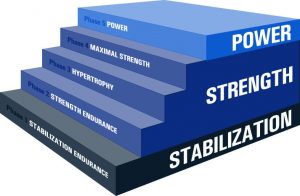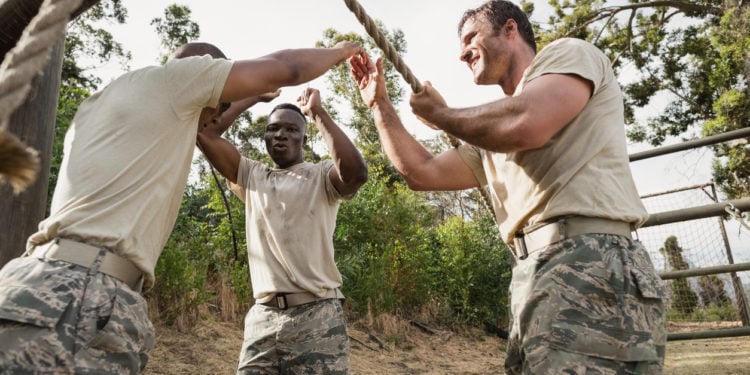From boot camp to retirement, military personnel face unique physical and mental challenges. Here’s expert insight from retired military members on adapting your training methods to help this group succeed.
NEW RECRUITS
- CHALLENGES New recruits vary in fitness level, weight and ability They need to prepare for initial training, such as boot camp or basic training. Some branches also have weight and/or BMI requirements.
- WORKOUTS NASM’s OPT™ model, with its focus on stabilization, strength, and power, is comparable to new-recruit training. Military training also focuses on stressful and combative situations, so workouts might include distractions such as chaotic music, unstable terrain, or drill-sergeant-style motivation. Running (at least 2 miles), isometric exercises, and swimming might also apply.
 NASM OPT Model
NASM OPT Model - RESOURCES Specific requirements for initial fitness tests vary from one service branch to the next. The official websites of each branch (GoArmy.com, GoCoastguard.com, Navy.com, Airforce.com, and Marines.com) can help give insight into expectations and proper form for exercises such as sit-ups.
ENLISTED/GENERAL/SPECIAL FORCES
- CHALLENGES Needs vary based upon the individual’s branch, unit, job specialty, and career goals. If a client’s military role is particularly demanding, he or she may be dealing with injury or imbalances. Keep in mind that fitness requirements decrease as age increases—and increase as combat duties increase.
- WORKOUTS Remember, military personnel must pass a regular physical fitness test. Workouts should be tapered prior to these tests to improve performance. Also, think of special operations personnel as you would a professional athlete: They are held to a higher standard of fitness. To increase difficulty, have clients wear a weighted vest or carry weights to mimic the burden of combat gear.
- RESOURCES NASM’s Performance Enhancement Specialist (PES) program is a benefit for this group. It will help you teach clients to operate in multiple planes of motion—a key skill for military members, particularly those who see combat. Another option: Corrective Exercise Specialist (CES) training, which can help you reduce clients’ risk of injury, improve posture, and relieve pain.
Special Offer for Military Personnel and Spouses!
RETIRED MILITARY
- CHALLENGES Members of the military can retire as young as age 38, so this covers a wide age range. Also, those in this group may have sustained some type of injury. Even those with more sedentary careers may have limitations, such as lower-back pain.
- WORKOUTS Carefully assess this population when creating a program. For clients who miss the challenges of combat, mixed martial arts (MMA) might be a good fit. Retirees may enjoy the camaraderie of forming a team and competing in an adventure race that includes running, obstacles, and other challenges.
- RESOURCES Various specializations might apply. Examples: Senior Fitness Specialist (SFS) training can help you create programs to maintain muscle mass while avoiding injury. Weight Loss Specialist (WLS) training can show you how to help the many retirees who gain weight after exiting the service.

















